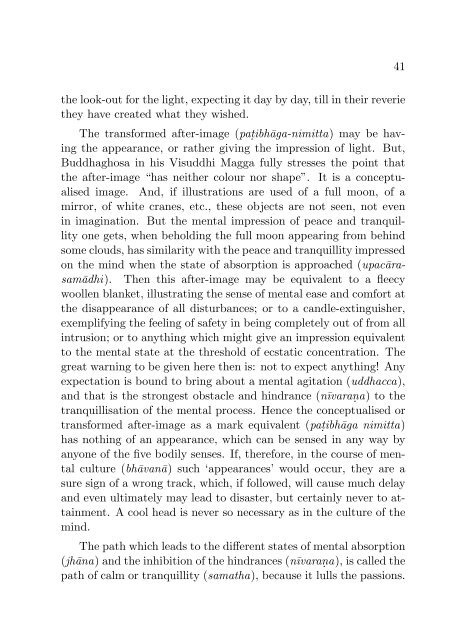Agony and Ecstasy
A comparative study of the five hindrances, together with the five states of concentration or mental absorption.
A comparative study of the five hindrances, together with the five states of concentration or mental absorption.
You also want an ePaper? Increase the reach of your titles
YUMPU automatically turns print PDFs into web optimized ePapers that Google loves.
41<br />
the look-out for the light, expecting it day by day, till in their reverie<br />
they have created what they wished.<br />
The transformed after-image (paṭibhāga-nimitta) may be having<br />
the appearance, or rather giving the impression of light. But,<br />
Buddhaghosa in his Visuddhi Magga fully stresses the point that<br />
the after-image “has neither colour nor shape”. It is a conceptualised<br />
image. And, if illustrations are used of a full moon, of a<br />
mirror, of white cranes, etc., these objects are not seen, not even<br />
in imagination. But the mental impression of peace <strong>and</strong> tranquillity<br />
one gets, when beholding the full moon appearing from behind<br />
some clouds, has similarity with the peace <strong>and</strong> tranquillity impressed<br />
on the mind when the state of absorption is approached (upacārasamādhi).<br />
Then this after-image may be equivalent to a fleecy<br />
woollen blanket, illustrating the sense of mental ease <strong>and</strong> comfort at<br />
the disappearance of all disturbances; or to a c<strong>and</strong>le-extinguisher,<br />
exemplifying the feeling of safety in being completely out of from all<br />
intrusion; or to anything which might give an impression equivalent<br />
to the mental state at the threshold of ecstatic concentration. The<br />
great warning to be given here then is: not to expect anything! Any<br />
expectation is bound to bring about a mental agitation (uddhacca),<br />
<strong>and</strong> that is the strongest obstacle <strong>and</strong> hindrance (nīvaraṇa) to the<br />
tranquillisation of the mental process. Hence the conceptualised or<br />
transformed after-image as a mark equivalent (paṭibhāga nimitta)<br />
has nothing of an appearance, which can be sensed in any way by<br />
anyone of the five bodily senses. If, therefore, in the course of mental<br />
culture (bhāvanā) such ‘appearances’ would occur, they are a<br />
sure sign of a wrong track, which, if followed, will cause much delay<br />
<strong>and</strong> even ultimately may lead to disaster, but certainly never to attainment.<br />
A cool head is never so necessary as in the culture of the<br />
mind.<br />
The path which leads to the different states of mental absorption<br />
(jhāna) <strong>and</strong> the inhibition of the hindrances (nīvaraṇa), is called the<br />
path of calm or tranquillity (samatha), because it lulls the passions.

















